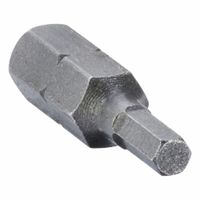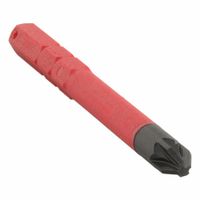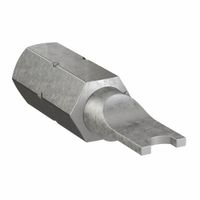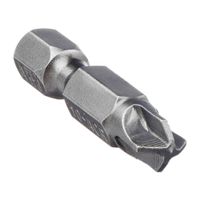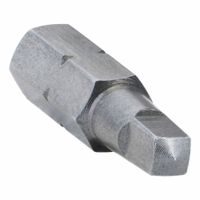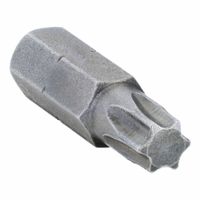Call +(254) 703 030 000 / 751 483 999 / 721 704 777
- Home
- Tools
- Sockets Bits
- Screwdriver Bits
.....Read More
Frequently Asked Questions
What are the different types of screwdriver bits?
Screwdriver bits come in various types, each designed for specific screw head types and applications. Here are the most common types:
1. **Phillips (PH):** Characterized by a cross-shaped tip, Phillips bits are designed to fit into the corresponding cross-shaped recess of Phillips screws. They are widely used in many applications.
2. **Flathead/Slotted:** These have a flat, straight blade that fits into the single slot of flathead screws. They are one of the oldest types of screwdriver bits.
3. **Torx (T):** Featuring a star-shaped tip with six rounded points, Torx bits provide high torque transfer and are commonly used in automotive and electronics industries.
4. **Pozidriv (PZ):** Similar to Phillips but with additional lines between the cross, Pozidriv bits offer better torque and reduced cam-out, making them suitable for woodworking and construction.
5. **Hex (Allen):** These bits have a hexagonal tip and are used for hex screws, often found in furniture assembly and machinery.
6. **Square/Robertson:** With a square-shaped tip, these bits fit into square recesses and are known for their high torque and reduced cam-out, popular in woodworking.
7. **Security Bits:** These include variations like Security Torx, Security Hex, and others, featuring unique designs to prevent tampering.
8. **Tri-Wing:** With a three-winged tip, these bits are used in electronics and appliances to prevent unauthorized access.
9. **Spanner:** Featuring two prongs, spanner bits are used for security screws in public installations.
10. **Clutch:** These have a bow-tie shape and are often used in automotive and industrial applications.
Each type of bit is available in various sizes to match the corresponding screw head, ensuring proper fit and function.
How do I choose the right screwdriver bit for my project?
1. **Identify the Screw Type**: Determine the type of screw you are using. Common types include Phillips, flathead (slotted), Torx, square (Robertson), and hex. Each requires a specific bit shape.
2. **Match the Size**: Ensure the bit size matches the screw head size. Using a bit that is too small or too large can strip the screw or damage the bit. Bits are often numbered or lettered to indicate size.
3. **Consider the Material**: Choose a bit made from a material suitable for your project. High-speed steel (HSS) is common for general use, while titanium or cobalt bits are better for harder materials.
4. **Check the Bit Length**: Select a bit length that provides adequate reach for your project. Longer bits are useful for deep or hard-to-reach screws, while shorter bits offer more control.
5. **Evaluate the Drive Type**: Consider whether you need a manual or power-driven bit. Power bits are designed for use with drills or impact drivers and often have a hex shank for quick changes.
6. **Assess the Bit Quality**: Higher quality bits are more durable and less likely to strip screws. Look for bits with hardened tips or those labeled as impact-rated for heavy-duty use.
7. **Consider the Project Requirements**: For precision work, such as electronics, choose bits that offer fine control. For construction or woodworking, durability and strength are more critical.
8. **Test Fit**: Before starting, test the bit in the screw head to ensure a snug fit. The bit should sit securely without wobbling.
9. **Use a Bit Holder**: For added convenience and to prevent slipping, use a magnetic bit holder, especially when working with power tools.
10. **Purchase a Set**: If you frequently work on various projects, consider investing in a comprehensive bit set to cover multiple screw types and sizes.
What is the difference between Phillips and Pozidriv bits?
Phillips and Pozidriv are both types of screw drive systems, but they have distinct differences in design and application.
Phillips screws and bits are characterized by their cross-shaped design with rounded edges. This design was created to allow the screwdriver to cam out, or slip, when a certain torque level is reached, preventing over-tightening and potential damage to the screw or workpiece. This makes Phillips screws suitable for applications where controlled torque is important.
Pozidriv screws and bits, on the other hand, are an evolution of the Phillips design. They feature a similar cross shape but with additional smaller ribs between the main arms of the cross. These ribs provide more contact points between the screw and the bit, reducing the likelihood of cam-out and allowing for higher torque application. Pozidriv screws are often used in applications where a more secure fit and higher torque are required.
Visually, Pozidriv screws can be identified by the additional lines or notches between the cross arms, often marked on the screw head. It's important to use the correct bit for each type of screw, as using a Phillips bit on a Pozidriv screw, or vice versa, can lead to slippage and damage to both the screw and the bit.
In summary, the main differences lie in the design and application: Phillips is designed to prevent over-tightening with intentional cam-out, while Pozidriv offers more grip and torque with reduced cam-out risk.
How do I maintain and store screwdriver bits?
To maintain and store screwdriver bits effectively, follow these steps:
1. **Cleaning**: After each use, wipe the bits with a clean, dry cloth to remove any debris or residue. For stubborn dirt, use a small brush or compressed air. Avoid using water to prevent rust.
2. **Inspection**: Regularly inspect the bits for wear and tear. Look for signs of rounding, chipping, or bending. Replace any damaged bits to ensure efficiency and safety.
3. **Lubrication**: Occasionally apply a light coat of machine oil to the bits to prevent rust. Wipe off any excess oil to avoid attracting dust.
4. **Organization**: Store bits in a dedicated case or organizer. Many come with labeled slots for different sizes and types, making it easy to find the right bit quickly. This also prevents loss and damage.
5. **Environment**: Keep the storage area dry and cool. Avoid humid or damp locations to prevent rust. If necessary, use silica gel packs in the storage case to absorb moisture.
6. **Magnetization**: If bits become magnetized, demagnetize them using a demagnetizer tool. Magnetized bits can attract metal shavings, which may interfere with their function.
7. **Usage**: Use the correct bit for each task to prevent damage. Applying excessive force or using the wrong size can wear out bits prematurely.
8. **Rotation**: If you have multiple sets, rotate their use to ensure even wear across all bits.
By following these steps, you can extend the life of your screwdriver bits and ensure they remain in optimal condition for future use.
Can I use a screwdriver bit with a drill?
Yes, you can use a screwdriver bit with a drill. Drills and screwdrivers are both essential tools in any toolkit, and many modern drills are designed to accommodate screwdriver bits, making them versatile for various tasks. To use a screwdriver bit with a drill, follow these steps:
1. **Select the Right Drill**: Ensure your drill has a variable speed setting and a clutch. Cordless drills are often preferred for this task due to their portability and ease of use.
2. **Choose the Correct Bit**: Select a screwdriver bit that matches the screw head type (e.g., Phillips, flathead, Torx). Ensure the bit is the correct size to fit the screw snugly.
3. **Insert the Bit**: Open the drill's chuck by rotating it counterclockwise. Insert the screwdriver bit into the chuck, ensuring it is centered and straight. Tighten the chuck by rotating it clockwise until the bit is securely held.
4. **Adjust the Drill Settings**: Set the drill to a low speed to prevent stripping the screw or damaging the material. Adjust the clutch to a lower setting to control the torque and avoid overdriving the screw.
5. **Drive the Screw**: Align the bit with the screw head and apply steady pressure. Start the drill slowly, increasing speed as needed. Maintain a straight alignment to prevent the bit from slipping.
6. **Safety Precautions**: Wear safety goggles to protect your eyes from debris. Keep hands clear of the drill bit and work area.
Using a screwdriver bit with a drill can save time and effort, especially for large projects. However, for delicate tasks, a manual screwdriver may offer better control.
What are security bits and when should I use them?
Security bits are specialized screwdriver bits designed to fit into screws with unique head patterns, which are often used to prevent tampering or unauthorized access. These screws are commonly found in electronics, appliances, and other devices where manufacturers want to restrict user access to internal components. Security bits come in various shapes, such as Torx with a pin in the center (often called Torx Security or Tamper-Resistant Torx), spanner, tri-wing, and hex with a pin, among others.
You should use security bits in the following scenarios:
1. **Device Repair and Maintenance**: When repairing or maintaining devices that use tamper-resistant screws, security bits are essential to safely open and access the internal components without damaging the screw heads.
2. **Preventing Unauthorized Access**: If you are assembling or installing equipment that should not be easily tampered with, using security screws and the corresponding bits can help deter unauthorized access.
3. **Professional and DIY Projects**: For professionals in electronics repair or DIY enthusiasts working on projects involving devices with security screws, having a set of security bits is crucial for versatility and efficiency.
4. **Compliance and Safety**: In industries where compliance with safety standards is necessary, using security screws and bits can ensure that only authorized personnel can access certain equipment, thereby maintaining safety and compliance.
5. **Vandalism Prevention**: In public installations, such as signage or fixtures, security screws can prevent vandalism or theft, and security bits are needed for installation and maintenance.
Security bits are a valuable tool for anyone dealing with tamper-resistant screws, providing the necessary access while maintaining the integrity and security of the device or installation.
How do I identify the size of a screwdriver bit I need?
To identify the size of a screwdriver bit you need, follow these steps:
1. **Determine the Screw Type**: Identify the type of screw head you are working with. Common types include Phillips, flathead (slotted), Torx, hex, and Robertson (square).
2. **Check the Screw Head Size**: Examine the screw head to determine its size. For Phillips and flathead screws, the size is often indicated by a number (e.g., #1, #2, #3 for Phillips). For Torx screws, the size is indicated by a "T" followed by a number (e.g., T10, T15). Hex screws are measured in millimeters or inches.
3. **Match the Bit to the Screw**: Use a screwdriver bit that matches the type and size of the screw head. The bit should fit snugly into the screw head without wobbling. For Phillips and flathead screws, ensure the bit size corresponds to the screw size. For Torx and hex screws, the bit should fit perfectly into the recess.
4. **Test the Fit**: Insert the bit into the screw head. It should fit securely without excessive play. A proper fit ensures efficient torque transfer and reduces the risk of stripping the screw.
5. **Use a Bit Gauge**: If available, use a bit gauge or a screw size chart to confirm the correct bit size. These tools can help you quickly match the bit to the screw.
6. **Consider the Application**: For precision work, such as electronics, use smaller bits. For construction or automotive tasks, larger bits may be necessary.
By following these steps, you can accurately identify the correct screwdriver bit size for your task, ensuring efficient and safe work.
